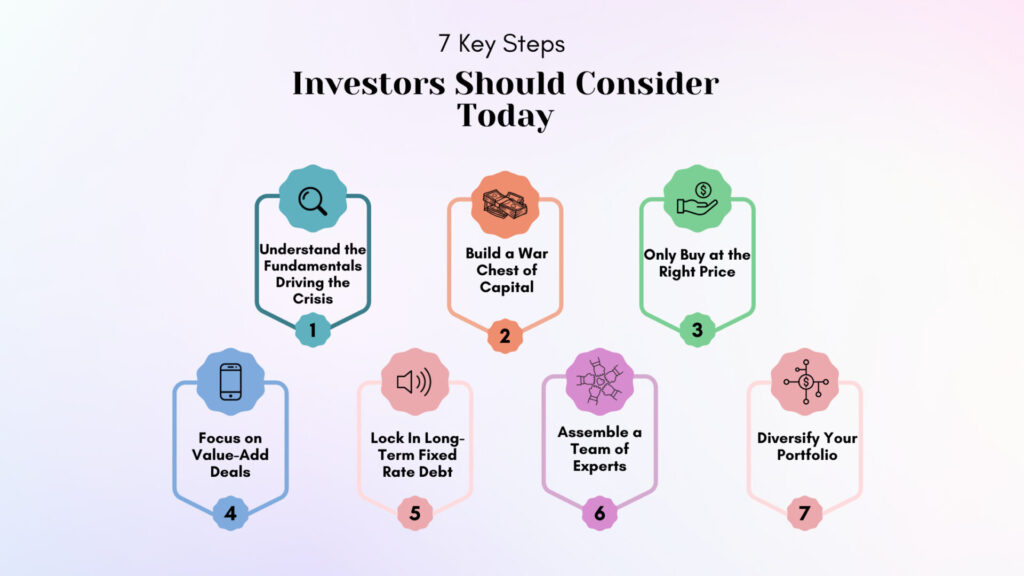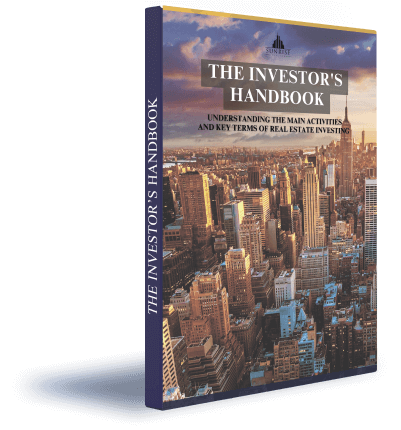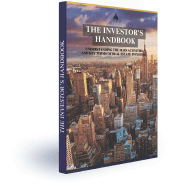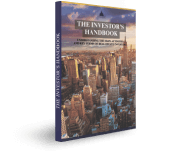This in-depth report analyzes the massive commercial real estate debt bubble, explaining how total Commercial Real Estate (CRE) debt has doubled since 2013 to over $3 trillion today. With the majority using adjustable rate financing, rising vacancies, falling rents, and spiking interest rates are converging to create a perfect storm. As loans reset beginning in 2025, waves of distressed CRE assets will hit the market at fire sale prices. Savvy investors who prepare can profit enormously.
Overview of the Massive Commercial Real Estate Debt Bubble
The United States commercial real estate (CRE) market is facing the largest debt bubble in history, yet most people are completely overlooking the catastrophic impacts this could have in the coming years.
Between 2013 and today, the total amount of CRE debt has more than doubled from $1.5 trillion to over $3 trillion. This is the highest amount of commercial real estate debt ever recorded, nearly double the previous peak before the 2008 financial crisis.
Unlike residential mortgages which are mostly fixed rate, the vast majority of commercial real estate debt uses adjustable rate mortgages (ARMs). This means the monthly payments on these loans can fluctuate up and down based on changes in interest rates.
During the real estate boom from 2020 to 2022, interest rates were at their lowest levels ever thanks to the Federal Reserve cutting rates repeatedly to near zero. This allowed property investors and developers to take on enormous amounts of adjustable rate debt at extremely low monthly payments.
However, now interest rates are rising at their fastest pace in decades, with the Fed Funds rate already increasing over 400 basis points in the past year. The Fed has clearly stated they expect to keep rates high into 2024 or longer to combat inflation.
By the end of 2025, around $1.5 trillion worth of commercial real estate debt will need to be refinanced at these new, much higher interest rates. This is setting up a massive cash flow crisis for many CRE owners.
Click here to learn more and subscribe to the newsletter
The Coming Cash Flow Crunch Will Crush Many CRE Owners
To understand the problem, let’s look at a hypothetical example:
A commercial real estate investor bought an office building for $10 million, putting down 30% as a down payment and financing the rest. The property generated $500,000 in net operating income (NOI) per year after all expenses. The investor financed the other $7 million at 4% interest on a 10-year adjustable-rate mortgage (ARM), meaning a $400,000 annual mortgage payment. This left the investor with $100,000 in positive annual cash flow the first few years.
Typically at refinancing, the investor would see their debt payments rise moderately but rents would also be rising to cover most or all of the increased costs. The investor could also tap into more equity to smooth over any short-term cash flow issues.
However, this time we are seeing a perfect storm hitting commercial real estate owners all at once:
Office vacancies are rising in most US markets, reducing net operating income (NOI). Rental rates for office space are falling nationwide, further reducing NOI. Interest rates are spiking above 8% on new loan originations. Property valuations are falling as lower NOI reduces appraisal values.
Going back to our example, let’s see how this plays out:
20% of the building became vacant, reducing net operating income (NOI) to $400,000. The $6.5 million mortgage was up for refinancing at the new higher rates. At 8% interest on the new loan, the annual payment spiked to $570,000. That resulted in $170,000 in negative cash flow annually.
On top of the negative cash flow, the valuation plummeted as well:
Based on the $400,000 NOI and an 8% capitalization rate, the property was now worth only $5 million. But the investor still owed $6.5 million on the old mortgage. They were now severely underwater, with their loan exceeding the value by $1.5 million.
This same situation is playing out for hundreds of billions worth of commercial real estate loans across the country. Owners are facing plunging valuations coupled with massive negative cash flow.
Try your personal AI-powered Real Estate Advisor completely for free
The Coming Wave of Distressed Commercial Real Estate Assets
As we approach 2025 and over $1 trillion in CRE debt needs to be refinanced, there simply is not enough tenant demand at high enough rental rates to support the inflated valuations and loans written from 2020 to 2022.
Expect a wave of distressed commercial real estate hitting the market, as owners simply can’t make the new higher loan payments and are forced to sell at steep discounts. We’re likely to see office buildings, retail centers, hotels, and other commercial real estate asset classes offered from 20 to 50 cents on the dollar compared to the peak valuations from just a couple years ago.
For savvy investors with cash available, huge opportunities will emerge to scoop up discounted properties and turn them around into profitable investments. But it requires understanding the market cycles and macroeconomic trends driving this opportunity.
Protect Yourself and Prepare to Capitalize on the Coming Downturn

Here are some key steps investors should consider today:
1) Understand the Fundamentals Driving the Crisis
Continue educating yourself on the CRE market, interest rates, and overall economy. The more you understand the root causes, the better prepared you’ll be to respond appropriately.
2) Build a War Chest of Capital
Having cash available to deploy into discounted deals will enable you to take full advantage of opportunities as distress hits the market. Park money in safe, liquid assets so it’s ready when the time is right.
3) Only Buy at the Right Price
Be disciplined in your approach and don’t reach for deals. Wait for prices to come to you and focus on properties where your cost basis will allow for strong cash-on-cash returns even at higher interest rates.
4) Focus on Value-Add Deals
Look for properties where you can increase cash flow through renovations, better management, and filling vacancies. Don’t rely on appreciation for your returns.
5) Lock In Long-Term Fixed Rate Debt
If possible, secure fixed rate financing for as long as possible, insulating yourself from further rate spikes. Variable rate debt is dangerous in this environment.
6) Assemble a Team of Experts
Partner with competent lenders, attorneys, brokers, property managers, and contractors who can help you successfully execute on your business plan.
7) Diversify Your Portfolio
Don’t put all your eggs in one basket. Target deals across different CRE sectors and geographic markets to mitigate risk and maximize opportunities.
The years ahead will undoubtedly bring challenges for many commercial real estate investors, but will also provide unique opportunities for those who are prepared. Position yourself now to weather the storm and capitalize on the coming wave of discounted distressed properties.
Conclusion
The impending debt crisis in commercial real estate has the potential to be more severe than 2008. With over $3 trillion in total commercial real estate debt and around half needing refinancing by 2025, enormous losses are likely as loans reset at much higher interest rates.
Many properties already face falling rents, rising vacancies, and plunging valuations. When loans reset, billions worth of CRE will end up “underwater”, with loan balances exceeding deteriorating property values. Waves of foreclosures and distressed properties hitting the market are expected.
Prudent investors who prepare now can profit enormously by buying discounted assets for cents on the dollar compared to recent peaks. But it requires capital reserves, patience, and working with experienced professionals.
The years ahead will be difficult for overleveraged commercial real estate owners but offer life-changing opportunities for those who understand the macro-trends and position themselves wisely. Take time to educate yourself, assess risks, and prepare to act decisively as opportunities emerge.
With the right mindset and preparation, the coming CRE correction can be your gateway to financial freedom. Study the markets, execute with discipline, and remain vigilant to prosper through the turbulent times ahead.
Are you interested in learning more about multifamily real estate investing? Our team of experienced professionals is here to help. Whether you’re looking for advice on conducting market research or need assistance in identifying the best investment opportunities, we have the knowledge and expertise to guide you through the process. Subscribe to our YouTube channel to access informative videos and expert discussions on multifamily real estate investing. Follow us on Instagram for inspiring visuals and exclusive content. Additionally, explore our comprehensive course on Udemy for detailed insights and strategies in multifamily real estate investing, designed to help you succeed. Check out our new customized ChatGPTs: Real Estate Investing Coach and Real Estate.
Ready to elevate your real estate investment journey? Contact us now to schedule a consultation and take the first step towards achieving your financial goals in the real estate and land development industry.
* This content is for informational purposes only and is not intended as financial or legal advice. Please consult with a professional advisor before making any investment decisions.


























